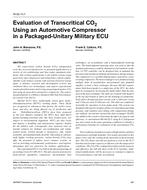-
-
Available Formats
- Options
- Availability
- Priced From ( in USD )
-
Available Formats
-
- Immediate download
- $16.00
- Add to Cart
Customers Who Bought This Also Bought
-

HI-02-20-3 -- The Responsibilities of the Owner in Defini...
Priced From $16.00 -

HI-02-18-2 -- Development and Testing of a Reformulated R...
Priced From $16.00 -

HI-02-13-1 -- Evaluation of Transcritical CO2 Using an Au...
Priced From $16.00 -

HI-02-07-2 (RP-1073) -- Determination of Refrigerant Lowe...
Priced From $16.00
About This Item
Full Description
Using weather data in joint-frequency bin format, the primary energy consumption of a vapor-compression system and a hybrid system consisting of vapor compression with an enthalpy wheel, using three different reheat options, are compared. The reheat options modeled were free (i.e., condenser waste heat or any other free energy source), electric, and gas.The calculations were performed for Atlanta, Georgia, using a spreadsheet containing joint-frequency weather data for a year.Previously,the ventilation load index (VLI)was used as an indicator of the amounts of sensible and latent loads associated with specific geographic weather data sets. This work investigates the total Source Energy Ventilation Load Index (SEVLI) as an indicator of the total energy consumed, on a source energy basis, for each system configuration. The results highlight the advantages of using an enthalpy wheel in conjunction with a vapor-compression system and the disadvantages of using subcooling to remove excess moisture and reheat due to their excessive source energy consumption.
Units: Dual





